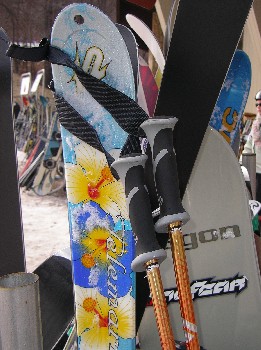
I spent a weekend in Canaan Valley, West Virginia taking a telemark workshop offered by North American Telemark Organization (NATO) in January. We were supposed to learn backcountry techniques, but there was no snow left in the woods. It was even pouring the first day, and our clothes were twice as heavy as they used to be after the class.
Nevertheless Dickie Hall, the founder of NATO, still taught us ski waxing. Ski waxes are marked by colors: blue, red, green, and so on. They might be soft and sticky or hard. You apply different waxes on your skis based on the snow condition.
Dickie taught us a quick simple way to identify the snow condition, which is to make a snowball. A snowball can be dry and easy to break, dry but stay contingent, wet but doesn’t leave a trace on your gloves, or damp and you can see water residue on your gloves. The art of ski waxing is to generate a mapping table between the status of the snowball and the color code of the wax. (I wish I could provide you the table here, but I only brought my skis but not a pen and a notebook.)
If you apply the right wax to your skis, you should be able to climb uphill by doing switchbacks. But if you want to climb straight up, then you have to use climb skin, it turns your skis into snowshoes.
I totally agreed with what Dickie described about the charm telemark skiing provides. You can take your telemark skis, go to a near-by hill, ski up and ski down. You will probably be the first people ski the hill and your next ski route will never repeat the previous one. I can only imagine it right now, but even so it soothes my adventurous mind.
According to sale numbers, the population of telemark skiers is growing. The only complaint that I have is that it is still not big enough in the mid-Atlantic area. I took two workshops this year: one was in Vermont and the other one was in West Virginia. Both took me a good six hours of driving one way. Luckily the quality of the lessons was really good, worth the driving. I recommend people who are thinking of taking telemark lessons to check out NATO.
一月份的時候,åƒåŠ 了由北美Telemark(NATO)組織開授的週末兩天課程。原本課程的è¨è¨ˆæ˜¯è‘—é‡åœ¨é‡Žå¤–滑雪的技巧的,åå今年的冬天太暖,樹林裡的雪都èžåŒ–了。甚至連第一天的課程都是在大雨滂沱的情æ³ä¸‹é€²è¡Œçš„。當天的課程çµæŸå¾Œï¼Œæ¯å¤©æ‰€è‘—è¡£æœçš„é‡é‡ï¼Œå¹³åœ°å°±æ·»äº†å…©å€ã€‚
儘管如æ¤ï¼Œå‰µè¾¦NATOçš„Dickie Hallä»ç„¶æ•™æŽˆäº†ç‚ºé›ªå…·ä¸Šè Ÿçš„知è˜ã€‚基本上來說,å„種ä¸åŒçš„è Ÿï¼Œæœƒä»¥ä¸åŒçš„é¡è‰²æ¨™ç¤ºï¼›æœ‰çš„è Ÿè»Ÿç¶¿ç¶¿ã€æœ‰çš„è Ÿé»ææã€æœ‰çš„è Ÿå‰‡æ˜¯ç¡¬æ¢†æ¢†ã€‚è€Œè©²ç”¨ä»€éº¼é¡è‰²çš„è Ÿï¼Œç«¯çœ‹ç•¶å¤©çš„é›ªæ³è€Œå®šã€‚
Dickie說,一個簡單快速的判別雪æ³çš„æ–¹å¼ï¼Œå°±æ˜¯ä»¥é›™æ‰‹æ§é›ªè£½ä½œä¸€å€‹é›ªçƒã€‚雪çƒçš„狀態å¯ä»¥æ˜¯ï¼šä¹¾è€Œå®¹æ˜“碎裂ã€ä¹¾ä½†æ˜¯é›ªçƒå½¢ç‹€å®Œæ•´ã€æ¿•ä½†æ˜¯æ²’有沾濕手套ã€æ¿•åœ°å¾ˆä¸”在手套上留下水漬ç‰ã€‚è€Œé›ªå…·ä¸Šè Ÿçš„è—術,就是在腦ä¸å°‡ä¸åŒçš„雪çƒç‹€æ…‹ï¼Œå’Œè Ÿçš„é¡è‰²æ¨™ç¤ºé€£çµèµ·ä¾†ã€‚(å¯æƒœé€™è£¡æ²’有辦法æ供這個å°ç…§è¡¨ï¼ŒåŽ»ä¸Šèª²çš„時候,åªå¸¶äº†é›ªå…·ï¼Œå»æ²’帶紙ç†ï¼‰
如果給雪具上æ£ç¢ºçš„è Ÿï¼Œå°±å¯ä»¥ç©¿è‘—雪具以Zå—形的方å¼ï¼Œæœå±±é 往上爬。但是如果想è¦ä»¥æœ€çŸçš„è·é›¢è¡ä¸Šå±±é ‚,æ怕就需è¦ç‚ºé›ªå…·å¥—上攀爬用的「climb skinã€ï¼Œå¥—上之後,就å¯ä»¥æŠŠé›ªå…·ç•¶é›ªéž‹ä¾†ç”¨äº†ã€‚
Dickie當天說了Telemark skiçš„é…åŠ›æ‰€åœ¨ï¼Œè®“äººç›¸ç•¶ç¥žå¾€ã€‚è©¦æƒ³ä½ å¯ä»¥å¸¶è‘—ä½ çš„telemark雪具,到家附近的å°å±±ä¸˜ï¼Œç”¨è©²é›ªå…·çˆ¬ä¸Šä¸”滑下,æžä¸å¥½ä½ å¯ä»¥å®£ç¨±ä½ 是在該山丘滑雪的第一人。而下一次å†åŽ»æ»‘雪,使用的旅徑,也ä¸æœƒè·Ÿä¸Šä¸€æ¬¡é‡è¤‡ã€‚雖然ç¾åœ¨æˆ‘å…‰åªèƒ½æƒ³åƒæ¤æƒ…æ¤æ™¯ï¼Œå»ä¼¼ä¹Žä¹Ÿå¯ä»¥å®‰æ’«æƒ³è¦å†’險éŠçŽ©çš„心。
æ ¹æ“šéŠ·å”®æ•¸å—的統計,telemark ski在美國的人å£ä¼¼ä¹Žä»¥å¾ˆå¿«çš„速度在æˆé•·ä¸ã€‚我唯一的抱怨則是,這個é‹å‹•ä¼¼ä¹Žåœ¨mid-Atlantic地å€é‚„ä¸å¤ 大。這個冬å£æˆ‘總共上了兩次課程,一次在Vermont,å¦ä¸€æ¬¡å‰‡æ˜¯åœ¨West Virginia,æ¯æ¬¡æˆ‘都è¦èŠ±å…個å°æ™‚開車,而這åªæ˜¯å–®ç¨‹çš„æ™‚é–“ã€‚å¹¸å¥½ï¼Œèª²ç¨‹çš„å…§å®¹ç›¸ç•¶å……å¯¦ï¼Œé–‹é‚£éº¼ä¹…çš„è»Šä¹Ÿç®—æ˜¯åˆ’ç®—äº†ã€‚å¦‚æžœä½ ä¹Ÿæƒ³è¦å¸telemark,NATOæˆ–è¨±æ˜¯ä½ ä¸éŒ¯çš„é¸æ“‡ã€‚

Pingback: Final Frontier: An Outdoor Blog » Blog Archive » Concepts I Learned about Telemark SkiingTelemark skiingçš„å¸ç¿’心得
猛一看以為是 “ä¸Šè Ÿç† è¨˜”
嚇了å°å°ä¸€è·³
幾天沒來,å°po這裡變得很專æ¥å“¦
åŠ æ²¹!! 我愈來愈愛看這裡了。
kathy,
è¬è¬ä½ 唷,本來還在想最近的內容會ä¸æœƒå¤ªã€Œç¡¬ã€äº†äº›ï¼Œæƒ³èªªæ‡‰è©²å¯«äº›æ–°ä¾†çš„貓咪的軟性故事æ‰å¥½ …